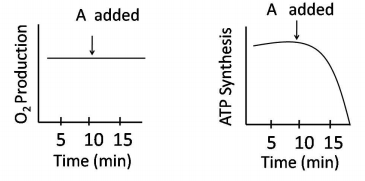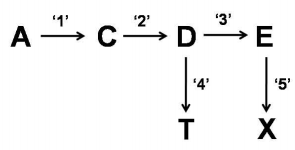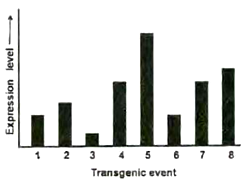 Multiple Choice Questions
Multiple Choice Questions'A' is an inhibitor of chloroplast function. The production of O2 and the synthesis of ATP are measured in illuminated chloroplasts before and after addition of 'A" as shown below:

Which statement is correct?
'A' inhibits the reduction of NADP+.
'A" inhibits the proton gradient and the reduction of NADP+.
'A' inhibits the proton gradient but not the reduction of NADP+.
'A' inhibits neither the proton gradient nor the reduction of NADP+.
Engineering of metabolic pathways in plants can be achieved by introduction and overexpression of appropriate candidate gene(s) using transgenic technology. The figure given below represents a biochemical pathways in plants where a precursor molecule 'A' is converted into products 'T' and 'X' through a series of enzymatic reactions. Enzymes 1-5 are involved in this pathway. Scientists attempted to increase the level of 'X' by introducing an additional copy of the gene for enzyme '5' under transcriptional control of a strong constitutive promoter. However, the developed transgenic plants did not display a proportionate increase in the level of 'X'.

The following statements were proposed for explaining the above results:
A. Enzyme '4' has a greater affinity for D than enzyme '3'.
B. Feedback inhibition of enzyme '5' compound X.
C. Substrate limitation for enzyme '5'.
Which of the above statements could represent probable reasons for NOT obtaining a proportionate increase in the amount of X in the transgenic plants?
Only C
Only A and B
Only A
A, B, and C
A single copy homozygous transgenic plant containing the transgene A for fungal resistance was subsequently re-transformed with another gene 'B' for conferring resistance to salt-stress. The selection marker genes used for both the transformation experiments were different. Transgenic plants obtained following the re-transformation were screened for salt-stress resistance and single cop evens were identified by Southern hybridization. These single copy events were self-pollinated. In the event of the two T-DNAs (containing the A and B transgenes) getting integrated in unlinked locations in all the transgenic plants, the phenotypic ratios among the T1 progeny would be:
3 (Fungal resistant + Salt-stress resistant): 1 (Fungal resistant)
1 (fungal resistant) : 2 (Fungal resistant + salt stress resistant): 1(salt-stress resistant)
3 (Salt-stress resistant): 1(fugal resistant)
1(Fungal resistant): 1(Salt-stress resistant):1 (fungal resistant + salt stress resistant)
In an experiment to determine the number of rats in a field, 80 rats were initially captured, marked, and released. After one month, 100 rats were captured in the same field, of which 20 were previously marked ones. Based on the above observation, estimated population size of the rats in the field will be:
160
200
400
1600
A species of grass grows around a mine area having patches of heavy metal contaminated soil. Some of the populations of the species grew selectively on the soil that was contaminated with metals. Over a period of time, through the tolerant and non-tolerant grass populations that were continuously distributed and not separated by geographical barriers, they eventually evolved different species. What kind of speciation would you call this?
Allopatric speciation
Sympatric speciation
Parapatric speciation
Bottle-neck effect
A T0 transgenic plant containing a transgene for herbicide resistance shows two bands on Southern blot analysis using a probe that is internal to the restriction sites used for genomic DNA digestion. However, it segregates in a 3:1 ratio for herbicide resistance: sensitivity in the T1 progeny obtained b self-pollination. Which one of the following statements is correct?
The T0 plant is a single-copy event.
The T0 plant is a double-copy event and the two transgene copies are tightly linked.
The T0 plant is a double-copy event and the two transgene copies are integrated in two chromosomes.
The T0 plant contains two unlinked copies of the transgene, both of which are truncated versions of the herbicide resistance gene.
Which one of the following statements regarding crop improvement program using molecular breeding approaches is incorrect?
Allelic diversity for traits of interest should be available in the naturally occurring crossable germplasm.
The gene/s of interest cannot be derived from a sexually incompatible organism.
The availability of markers and linkage maps would facilitate the breeding program.
The crop plant should necessarily have an optimized robust system for the production of doubled haploids.
D.
The crop plant should necessarily have an optimized robust system for the production of doubled haploids.
The crop plant should necessarily have an optimized robust system for the production of doubled haploids is an incorrect statement regarding crop improvement programs using the molecular breeding approach.
Agrobacterium-mediated transformation was used to generate transgenic plants using a construct with a selection marker gene 'X' and a passenger gene 'Y'. Expression levels of 'Y' protein in eight independent transgenic plants are given below:

The following could represent probable reasons for the observed variability in transgene expression levels
A. Position effects on passenger gene.
B. Transgene silencing of the marker gene.
C. Variation in copy number of passenger gene.
D. mRNA instability of marker gene.
Which one of the following combinations of above statements is correct?
A and C
C and D
B and D
A and B
Given below are four statements regarding genetic transformation of plants in the laboratory:
A. Plants incapable of sexual reproduction cannot be transformed by Agarobacterium tumefaciens.
B. Integration of transgene in organellar (chloroplast) genome occurs primarily by homologous recombination.
C. An enhancer trap construct used in Agrobacterium-mediated transformation would contain a functional coding sequence of a reporter and a minimal promoter.
D. A T0 transgenic plant containing two unlinked copies of a selection marker gene (hpt) and one copy of the passenger gene (gfp) would segregate in a 1 : 1 ratio for hygromycin resistance : sensitivity in the backcrossed progeny grown on selection are correct?
A and D
B and C
A and C
B and D
Several fusion constructs were developed to purify heterologous protein in E.coli. The table below lists fusion partners and ligands.
| Partner | Ligand |
| i. Maltose binding protein | a. Specific monoclonal antibody |
| ii. Streptavidin | b. Nickel |
| iii. Glutathione-S-transferase | c. Glutathione |
| iv. Flag-tag | d. Amylose |
| v. 6-Histidine tag | e. Biotin |
Which one of the following is the correct match of the fusion partner with the ligand?
i - b; ii - d; iii - c; iv - a; v - e
i - d; ii - b; iii - e; iv - c; v - a
i - d; ii - e; iii - c; iv - a; v - b
i - c; ii - d; iii -a; iv - b; v - e
